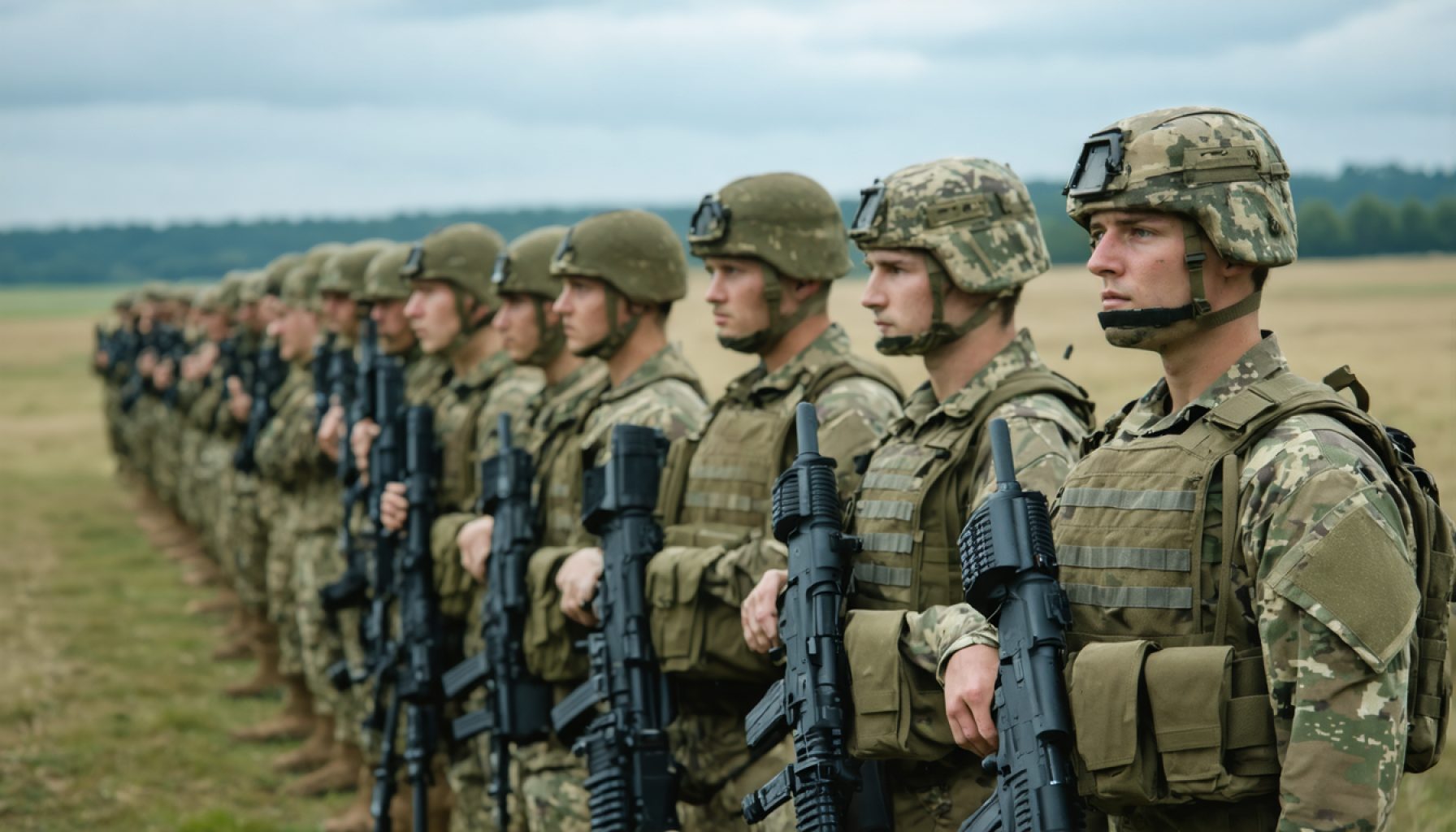- Nearly 2,500 UK troops participate in NATO’s Exercise Steadfast Dart near the Ukrainian border, highlighting allied unity and military readiness.
- Brigadier Andy Watson leads the forces, prepared for potential deployment into Ukraine if needed.
- The British political landscape hints at support for deployment post-ceasefire, amid discussions of force composition.
- The UK showcases its rapid mobilization capabilities, moving over 700 vehicles across Europe for the exercise.
- Experts debate the significant troop numbers required for Ukraine’s stabilization, with estimates exceeding 100,000.
- European nations push for more U.S. involvement, recognizing America’s deterrence as vital against Russian threats.
- The exercise emphasizes the necessity of collective action to maintain European stability and peace.
Under a biting Romanian sky, the First Division of the British Army pivots through daunting military drills, ready for anything. Nearly 2,500 troops, part of the UK’s high readiness force, participate in Exercise Steadfast Dart, NATO’s grand showcase of allied unity and might. This vast military choreography unfolds just 16 miles from the tense Ukrainian border, echoing the urgency of safeguarding European stability.
Despite mobile phone bans during exercises, a ripple of anticipation weaves through the ranks. Discussions hint at a bold possibility: British boots on Ukrainian soil. Leading the charge, Brigadier Andy Watson stands committed, rallying his brigade to spring into action if the call comes.
Political winds in Britain swirl in tandem. Keir Starmer signals willingness to dispatch forces post-ceasefire, though the mission remains shrouded in uncertainty. Brigadier Watson muses on the scale, aware that any force configuration requires careful deliberation between the Prime Minister and the Ministry of Defense, highlighting the UK’s role as part of a larger coalition.
This dance of strategy isn’t just NATO’s largest exercise this year; it’s a testament. The UK mobilizes with impressive speed, transporting over 700 vehicles 1,400 miles across Europe. Yet, the sheer scale needed to truly stabilize Ukraine looms large—some experts argue over 100,000 troops may be necessary.
As European nations jockey for defense prominence, America, NATO’s stalwart, stands conspicuously apart. Britain and allies appeal for U.S. involvement, knowing its deterrence is crucial against Russian aggression.
Every maneuver under Exercise Steadfast Dart reinforces a lesson: only together can Europe and its allies secure lasting peace. The British Army trains with vigor, aware that their readiness might one day be a linchpin in a global effort to stabilize the heart of Eastern Europe.
Could British Troops Be Deployed to Ukraine? What Exercise Steadfast Dart Reveals
**How-To Steps & Life Hacks: Understanding Military Drills**
Military exercises like NATO’s Exercise Steadfast Dart are meticulously planned to test readiness and improve coordination among allied forces. For those interested in organizing or understanding such large-scale drills, here are some insights:
1. **Establish Clear Objectives:** Define what the exercise aims to achieve, such as testing interoperability or readiness.
2. **Select Participants:** Involve relevant military units and personnel, ensuring diversity for multifaceted scenarios.
3. **Logistics Planning:** Prepare for transportation of troops and vehicles—NATO moved over 700 vehicles across Europe for this exercise.
4. **Develop Scenarios:** Create realistic situations that troops may face, such as conflict zones near strategic borders.
5. **Conduct Communication Drills:** Even under restrictions like mobile phone bans, ensure robust internal communication systems.
6. **Evaluate Outcomes:** After the exercise, debrief to identify strengths and areas of improvement.
**Real-World Use Cases: NATO Exercises**
NATO exercises serve several purposes:
– **Deterrence:** Display military capabilities to discourage potential aggressors.
– **Readiness and Responsiveness:** Enhance the ability to quickly deploy forces when needed.
– **Interoperability:** Ensure different nations’ military systems and procedures can work together.
**Market Forecasts & Industry Trends**
The backdrop of geopolitical tensions, such as those near the Ukrainian border, suggests continued investment in defense and readiness:
– **Increased Defense Budgets:** Countries are likely to allocate more financial resources to military readiness and equipment.
– **Technological Innovation:** Integration of advanced technologies like AI and unmanned vehicles in military operations is rising.
– **Growing NATO Cooperation:** Shared threats may lead to deeper alliances and joint exercises.
**Reviews & Comparisons**
Experts view Exercise Steadfast Dart favorably for highlighting NATO’s collaborative strength. However, comparisons to past exercises suggest a growing emphasis on rapid deployment and adaptability.
**Controversies & Limitations**
Deploying British troops to Ukraine is fraught with political and strategic risks:
– **Political Sensitivities:** Commitment to post-ceasefire troop deployment depends on evolving diplomatic landscapes.
– **Resource Intensiveness:** Experts estimate stabilizing Ukraine might require upwards of 100,000 troops.
**Features, Specs & Pricing**
While Exercise Steadfast Dart’s “features” revolve around military capabilities, future NATO endeavors might incorporate emerging technologies like:
– **Drones:** For reconnaissance and strategic advantage.
– **Cybersecurity Tactics:** Strengthening digital infrastructures and cyber defenses.
**Security & Sustainability**
– **Security:** Exercises like Steadfast Dart are fundamental in bolstering security, yet they must continually adapt to new threats, especially cybersecurity threats.
– **Sustainability:** Environmental implications of military operations are gaining attention, with growing efforts to reduce carbon footprints during exercises.
**Insights & Predictions**
– **NATO’s Role:** Expect NATO to maintain a critical role in European defense, adapting strategies to political changes.
– **US Involvement:** As European nations bolster defenses, U.S. participation remains pivotal in balancing power against adversaries like Russia.
**Tutorials & Compatibility**
While military exercises require professional training, understanding military strategies can be pursued through academic military history courses or defense strategy workshops.
**Pros & Cons Overview**
**Pros:**
– **Deterrence:** Demonstrates power and readiness, discouraging aggression.
– **Collaboration:** Enhances alliances and partner cooperation.
**Cons:**
– **Political Tensions:** Can escalate geopolitical strains.
– **Resource Demand:** High financial and human resource costs.
**Actionable Recommendations**
– For those interested in military studies or careers, consider pursuing relevant education in defense strategy or international relations.
– Stay informed on geopolitical developments to understand how they might influence global defense strategies.
**Related Links**
For further information on NATO’s strategic initiatives, visit NATO. For news on British defense policies, refer to UK Government resources.
By understanding these dynamics, readers can better comprehend the strategic imperatives that guide military operations today and in the future.
